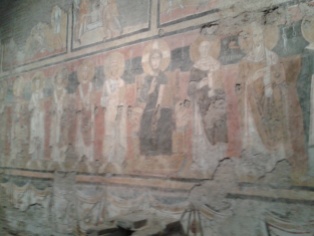Flowers
I didn’t usually notice the flowers in the church, but they were particularly beautiful. While I was admiring the mixture of creams and whites and greenery in front of the altar, I realised that there were another two vases on either side of the altar. Two smaller vases stood on either side of Jesus’ feet. Mary hadn’t been left out; she had two vases of her own, making a total of seven.
Seven vases of flowers. Who needed that many in a church? They served no purpose except to look nice and add a bit of grace to the altar. Surely one wee bunch could do the job. They were nice to look at, but we could do without them. The only flowers that made it into the wee church of my childhood were the silk ones on the ladies’ hats, and it never occurred to us that a few fresh ones might brighten the place up a bit.
These flowers were lovely, but was it right to buy expensive ones like lilies. I hated to think how much they had cost. Come to think of it, should the church be buying any flowers? They would be better spending the money on the poor.
Hmm. Wasn’t there a Gospel story which went something along these lines. I thought a moment, and then I had it. Mary anointed Jesus’ feet with expensive perfume, and then Judas Iscariot complained about the extravagance, suggesting that the money could have been better spent on the poor. Jesus accepted Mary’s extravagant gift by gently rebuking Judas, ‘You will always have the poor, but you won’t always have me.’ (John 12:8)
I accepted the rebuke and bent my head to concentrate on the Mass. If someone wanted to spend money filling the church with beautiful flowers as an expression of their gratitude to God, who was I to judge?
Everything in moderation?
After I got home, I realised that my cramped reaction to the flowers was very similar to my reaction to the Roman churches filled with art and decoration. My feeling in both cases was that neither flowers nor paintings were necessary in churches. A little of both might be permissible, but to fill the church with decoration was extravagant. Things like flowers and paintings which are there simply for their beauty, are probably just as indispensable as sleep.

When we collect, appreciate and try to create beautiful things, we are imitating God. He gives us beauty in profligate, reckless abundance. On top of our own world teeming with life, we have been given the amazing and humbling vastness of space. Here are a few facts:
- If you look up at the sky on a clear night, you will see a white smudge stretching across the sky. You are looking into just one of the spiral arms in our local Milky Way galaxy.
- The sun is just one of 100 billion stars in the Milky Way galaxy.
- There are thought to be around 100 billion galaxies in the observable universe.
- It takes light, travelling at 300 000 000 metres per second, four years to reach us from the closest star Proxima Centauri.
- Andromeda, our closest galaxy, is 2.5 million light years away.
Have a look at the scale of the universe . It is a great site which attempts to give people some kind of idea of the immensity of the universe.
Is God extravagant? There is no such thing as moderation when it comes to the universe. The facts speak for themselves.





